
Bat Star
Scientific Name Patiria miniata
Native To Pacific coast of North America (from Alaska to Baja Mexico)
Habitat Intertidal zone on the coast
Diet Other sea stars, tunicate worms and algae
Size and Age Up to 20 cm (8 in) in diameter; average lifespan of 5-35 years
Natural History
Bat stars are a pacific invertebrate dwelling in waters that are typically cold. They are so named for the bat-like webbing that exists between their five to nine arms. They come in a wide array of colors from red to green. Bat stars can be solid coloured or mottled in appearance. When they reproduce, males and females release their gametes into the water, which are then carried out to sea where they unite. Bat stars are an important part of ocean ecosystems; as detritivores and scavengers, they eat and clear away dead algae and animals from the ocean floor.
Least Concern

Conservation Status
Many ocean invertebrates require delicate and balanced conditions to survive. For this reason they are known as indicator species—when ocean conditions change, they are the first to be effected. Rising ocean temperatures, and ocean acidification, are currently major factors altering the health of our oceans. Bat stars are early indicators of these changes.
Interesting Facts
- Bat stars use gill-like structures on their backs to breathe.
- Unlike other sea stars, it is unable to open clams.
- Each arm of the bat star has a light sensing organ that is used to navigate its rocky environment and find prey.
- Bat stars may engage in combat, which includes pushing and laying an arm over their opponent.
- To eat, a bat star covers its prey with its stomach, then secretes digestive juices which liquefies it into food.
